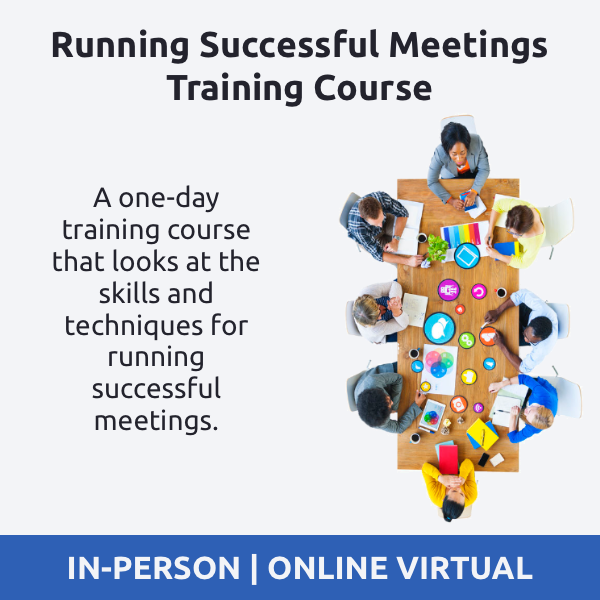[toc]
Why Have Effective Meetings?
Meetings are one of those things that seem to be unavoidable in business today. For some of us, they feel like a bit of a chore, but they are a very important communication tool.
If meetings are not run correctly they will feel like they become a bit of a drain on your time, so here are some top tips for effective meetings.
8 Tips for Effective Meetings
- Ensure your meeting has an objective or objectives – Rather than talk about what will be discussed in the meeting, think about what outputs the meeting will create. For example, avoid ‘we’re meeting to talk about last weeks sales figures’ and focus on ‘we’re meeting to develop some actions on how to achieve our sales targets for next week’. If you can’t think of an objective for your meeting you should ask yourself if a meeting is needed.
- Use and stick to an agenda – An agenda will help you and the other attendees focus on what needs to be discussed. Flip the agenda up and put it on the wall where it is always visible and use it to manage discussions, especially when the discussion goes ‘off-piste’.
- Capture things that can’t be answered – Don’t get drawn into what you think the answers to questions are. Use a ‘car park’ sheet or flip chart to capture those things you are unsure about then move on.
- Start with any other business – If you must have an ‘any other business’ section in your meeting, but it at the beginning. It seems unorthodox but you want the meeting to finish positively. You could go even further to say that if an item didn’t make the agenda then it won’t be discussed.
- Have a timekeeper – make sure someone is watching the time so you don’t over-run. Set out times for each discussion point then stick to it.
- Ensure everyone has their say – Don’t leave people out. Even if someone is being really quiet, ask them for their opinion.
- Finish on time – Ensure your meeting finishes at the agreed time. Overrunning will put people into a negative mindset making it harder to achieve your outcomes.
- Ensure your meeting has achieved its objectives – Check back through the objectives and ensure the meeting has driven the outcomes you were looking for.
Inviting People to Meetings
Inviting people to a meeting sounds like it should be a simple thing to do. Just pop them over a meeting invite, and that should be job done.
But, let’s reverse the role for a second. Think about how you feel when you just get a calendar invite sent to you asking you to attend a meeting. No agenda, no objectives and no details whatsoever about what the meeting is about. It doesn’t help or engage you and help with the motivation to attend, does it?
We see a lot of this. Now, consider how you feel when you arrive at the meeting. Are you feeling motivated and like you want to be there? Probably not!
It’s safe to say if this is how you would feel, then it’s highly likely that others will feel the same if this is how you invite them to a meeting.
If you want people to attend a meeting and want to be there and be fully engaged in the process, then there more to do than just sending a simple invite.
The engagement process starts well before the meeting. You need to help others to prioritise your meeting over everything else that you have going on. This means we need to add more detail to the meeting invite.
A meeting invite should have:
- A description of the purpose of the meeting – this should describe the ‘why’. It should set out the background and explain why the meeting has been called.
- The objective(s) of the meeting – what will the meeting drive out? Will it be decisions, actions, agreements. You need to help others see that there is value to the meeting.
- An agenda or order of discussion – this should set out the talking points that will be discussed during the meeting and how much time has been allocated to each.
When we deliver training courses that include sessions on how to run a successful meeting, we use a tool called a POP Template. This tool helps us to achieve all of the above. POP stands for Purpose, Objectives, Process.
By completing the document adding/pasting it into the meeting invitation, it allows for more successful meetings as it aims to help meeting delegates to become more engaged in the meeting before they even arrive.
It also helps others to effectively prioritise, meaning they should be able to come back to you and let you know that they have something that is more business-critical to work on rather than attend the meeting. This should be completely allowable.
You can read more about POP in the article POP – A Template for Inviting People to a Meeting on skilliki.com.
Running Successful Meetings Training Course
We hope you find these tips useful. You can find out more about holding effective meetings as well as improving other areas of your communication with our Successful Meetings Training Course. To get more information take a look at the Successful Meetings Training Course overview.



